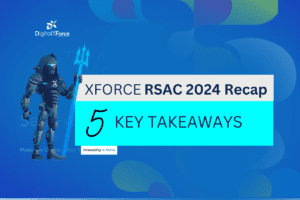
The RSA Conference 2024 in San Francisco brought together top minds in cybersecurity to discuss emerging threats, innovative solutions, and key industry trends. Our XForce team, under the leadership and guidance of CEO Lalit Ahluwalia, had the opportunity to attend and gather insights from renowned experts and thought leaders in the industry.
5 Key Takeaways from RSA Conference 2024
Here are five critical takeaways that stood out:
1. The AI Revolution in Cybersecurity
Artificial Intelligence (AI) is rapidly transforming the cybersecurity landscape, offering unprecedented speed, accuracy, and efficiency in detecting and mitigating threats. The conference underscored the widespread adoption of AI-powered tools for anti-phishing, scam protection, and various security services.
However, a word of caution was raised – not all AI technologies are created equal, and some may introduce vulnerabilities if not thoroughly vetted. As organizations embrace AI solutions, it is crucial to maintain transparency and control.
Many companies lack visibility into which AI tools are being used, by whom, and for what purpose. A balanced approach is necessary, harnessing AI’s potential while mitigating associated risks through rigorous testing, monitoring, and governance.
2. Need to Streamline Security Stacks for Efficiency and ROI
Security teams often grapple with complex and fragmented security stacks, comprising numerous products that may not integrate seamlessly. A lesser-discussed security challenge is the misalignment and misconfiguration of security stacks.
Most security stacks often have 50+ products, and they were not all designed to work in harmony. This complexity not only hinders operational efficiency but also impedes organizations from realizing the full return on investment (ROI) from their security investments.
Consolidating security platforms, aligning configurations, and fostering interoperability emerged as a key priority. By rationalizing their security stacks, organizations can reduce complexity, enhance threat visibility, and optimize their cybersecurity spending, ultimately improving their overall security posture.
3. Need to Converge IT, OT, and Physical Security for Critical Infrastructure Protection
The interconnectedness of IT, Operational Technology (OT), and physical security systems in critical infrastructure environments has highlighted the need for a holistic and integrated approach to security. Siloed strategies are no longer sufficient in the face of sophisticated threats that can exploit vulnerabilities across domains.
Industry experts emphasized the importance of automating security processes and fostering collaboration between IT, OT, and physical security teams. By converging these domains, organizations can achieve a comprehensive view of their risk landscape and implement coordinated defense strategies to safeguard their critical assets and operations. See: Strengthening OT Security Posture Against Pro-Russia Hacktivist Threats
4. Need for Proactive Threat Intelligence
In the ever-evolving threat landscape, where phishing, impersonation scams, and stolen credentials pose significant risks, businesses must shift their focus from reactive to proactive measures. Traditional security solutions, while essential, often address threats after they have already manifested, potentially causing damage.
Experts underscored the value of proactive threat intelligence, which enables organizations to identify and mitigate threats before they can cause harm. By leveraging advanced analytics, threat hunting, and early indicators of network attacks, businesses can stay ahead of adversaries and enhance their overall security posture.
5. Enterprise Security Posture Management Creates Digital Trust (Cyber Resilience)
Compliance alone is NOT SUFFICIENT to ensure robust cybersecurity. The conference highlighted the growing importance of Enterprise Security Posture Management (ESPM), which goes beyond traditional audit and compliance tools by offering real-time, continuous, and automated risk management and compliance capabilities.
ESPM platforms, such as DigitalXForce, empower organizations to instill digital trust and cyber resilience by providing comprehensive visibility into their security posture, identifying vulnerabilities, and enabling proactive risk mitigation.
By adopting an ESPM approach, companies can effectively manage their cybersecurity risks, maintain regulatory compliance, and foster a culture of trust with their stakeholders.
Conclusion
As the cybersecurity landscape continues to evolve, the insights and discussions from the RSA Conference 2024 underscore the need for a proactive, comprehensive, and adaptable approach to security. By embracing innovative technologies, fostering collaboration, and prioritizing risk management, organizations can enhance their cyber resilience and safeguard their critical assets from emerging threats.
 "Digital trust" cybersecurity solutions enabling automated, real-time risk mitigation are crucial for protecting organizations in today's threat landscape.
"Digital trust" cybersecurity solutions enabling automated, real-time risk mitigation are crucial for protecting organizations in today's threat landscape.